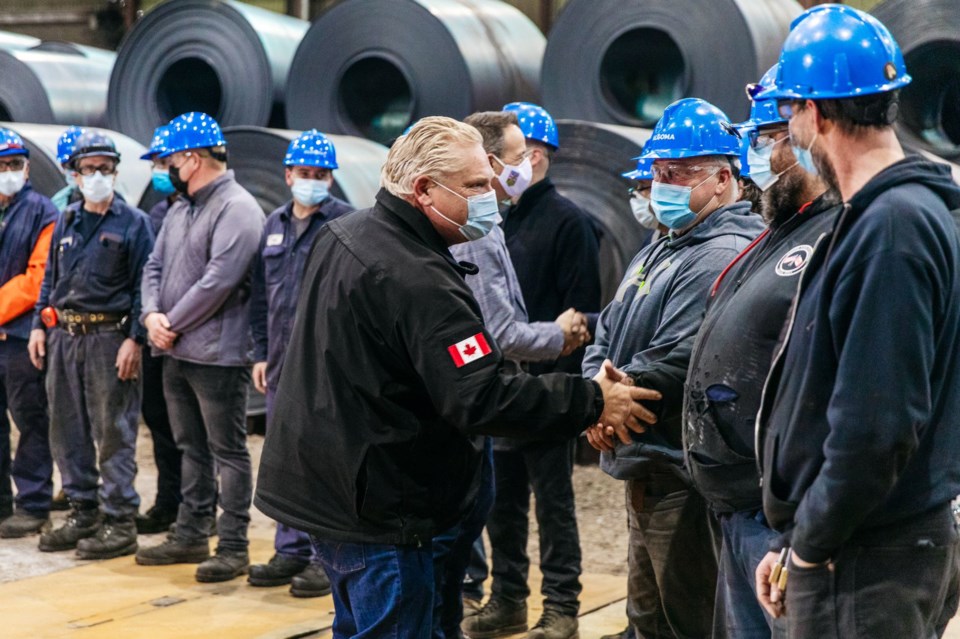Premier Doug Ford didn’t back down from his government’s commitment to invest in the development of a north-south road network into the Ring of Fire.
The premier and some provincial cabinet ministers were in Sault Ste. Marie on April 8, surrounded by steel coils on the floor of Algoma Steel’s Direct Strip Production Complex to unveil the province’s expanded Northern Energy Advantage Program (NEAP), a power rebate program for heavy industrial users in the North.
Ford’s visit to the Sault occurred the day after Ottawa committed billions of dollars toward a critical minerals and clean industry strategy. The federal budget item contained a slew of incentives and regulatory assistance for the mining industry to discover and prove up the next generation of mines and mineral deposits needed to feed the ‘green energy’ revolution and the high-tech economy.
A potential future source of those minerals could be the untapped resources in the Ring of Fire in the James Bay region.
Coincidentally, on the same day the budget was released, Australia’s Wyloo Metals finalized its takeover of Noront Resources’ nickel and mineral assets in the Far North mineral belt, some 500 kilometres northeast of Thunder Bay.
Ford was asked by the assembled media if he had been in conversation with the Australian mining company and if Sault Ste. Marie is still in the favoured landing spot for a ferrochrome processing plant, as chosen by Noront in 2019.
Ford answered he hadn’t been in direct discussions with the Perth-based company, but chose to double down on his government’s pledge to commit $1 billion in provincial funding to build a north-south access road to reach the “hundreds of billions” of dollars in untapped and valuable mineral resources.
Those proposed routes are undergoing a provincial environmental assessment.
According to an Infrastructure Canada document from 2019, the cost of building 450 kilometres of new road and to upgrade 97 kilometres of existing forestry road, in four sections, would be in the range of $1.1 billion to $1.6 billion. The province is still waiting on Ottawa for a “suggested” federal contribution of between $577 million to $779 million.
The road network will also connect the isolated First Nation communities of Marten Falls and Webequie to the provincial highway network for the first time. The premier found it “unbelievable” that remote First Nation communities must continue to fly in diesel fuel and food supplies. He promised the access road would change the lives of the people in those communities.
An enthusiastic Ford then dusted off and revived a campaign quote from his 2018 election run that angered environmental groups and some Indigenous communities opposed to mine-related development in the Far North.
“With the support of the First Nation communities, we’re going to both hop on that bulldozer and build that road as sure as I’m standing here.”
Ford and Northern Development Minister Greg Rickford used the event to hype this region’s role in the creation of a domestic industrial supply chain that the province is championing to connect Northern forestry, mining and manufacturing operations with the southern Ontario marketplace.
Critical minerals like nickel, platinum group metals, lithium, cobalt, and magnesium, of which Northern Ontario has a great abundance, is a big part of that strategy.
Part of that “green” technology movement includes Northern Ontario industrial mainstays like Algoma Steel, the Sault’s largest private sector employer.
Only three years ago, Algoma emerged from creditor protection, refinanced under new ownership, and embarked on an overdue plant modernization program that includes a $700-million investment in two electric furnaces.
Construction is now underway, creating 500 jobs in the process and long-term spinoffs for service and supply companies in the city.
This more efficient method of production will cut Algoma’s greenhouse gas emissions by 70 per cent.
Algoma CEO Mike McQuade said the continuation and enhancement of the Northern Energy Advantage Program provides companies like Algoma with the “clarity and certainty” to undertake such projects, makes the steelmaker more competitive, and ensures Algoma will be making steel in the Sault for “generations to come.”
The new and improved NEAP program will get a funding bump from $120 million in the pot every year to more than $176 million by 2026 allowing more companies to apply and qualify. Algoma is the first entrant in the new program.
A $20-million cap for applicants will be removed, said Rickford, to incentivize mining and forestry operations to ramp up production and not be hit with increased electricity costs when a certain threshold is reached.




